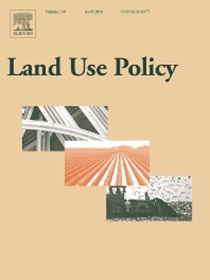数字技术在景观规划中的应用——文献综述
IF 5.9
1区 社会学
Q1 ENVIRONMENTAL STUDIES
引用次数: 0
摘要
本研究探讨数字技术在景观规划中的应用。目的是系统地绘制和评估数字技术在景观规划中的使用程度,并为进一步的研究提供指导,我们对2012年1月至2023年5月发表的53,114篇论文进行了范围审查。我们遵循PRISMA-ScR框架,结合半自动,数据图表和文献计量分析。这种方法使我们能够识别和分类相关文献、技术趋势和不同DT之间的相关性。我们开发的算法可用于LP中的DT监测。通过综合分析,我们确定了过去十年的趋势及其动态,技术演变的方向以及技术之间的相关性。我们确定了35项技术,并将其分为12类:遥感(RS);地理信息系统;其他数码建模(数学及统计);人工智能相关(ai相关);信息和通信技术(ICT);三维造型;数据;决策支持系统(DSS);机器人;虚拟现实/增强现实/混合现实(VR/AR/MR);社交媒体;和计算机辅助设计(CAD)。我们的分析显示,目前只有少数技术是规划过程中不可或缺的(RS、GIS、其他数字建模、人工智能相关和3D建模),而其他技术,如人工智能和数据技术,现在正在迅速发展,已经开始扩大其应用范围。机器学习(ML)和RS是最具活力的增长技术,而新兴技术包括其他ICT, BIM, VR/AR/MR和社交媒体。最显著的互反相关性是Data - RS - ai - related。本研究的重要意义在于全面描绘了数字技术在景观规划中的应用,为规划人员、政策制定者和研究人员提供了有价值的见解。主要结论表明,需要更多明确针对LP的技术知识,包括理解和关联它们在不同工艺阶段的可行性和应用,以及平滑的整体工作流程。虽然我们的范围界定文献综述提供了LP过程中DT的全面信息,但下一步是开发实用的工具箱本文章由计算机程序翻译,如有差异,请以英文原文为准。
The diffusion of digital technologies in landscape planning – A scoping literature review
This study investigates digital technologies (DT) in landscape planning (LP). The aim, was to systematically map and assess the degree of use of digital technologies in, landscape planning as well as propose guidance for further research, We performed a scoping review of 53,114 papers published from January 2012 until, May 2023. We followed the PRISMA-ScR framework, combined with semi-automated, data charting and bibliometric analysis. This approach allowed us to identify and, classify relevant literature, technology trends, and correlations between different DT.The algorithms we developed can be used to monitor DT in LP. By comprehensive, analysis, we identified trends and their dynamics over the last decade, the direction of technological evolution, and correlations between the technologies. We identified 35 technologies, which we grouped into 12 categories: Remote Sensing (RS); Geographical Information Systems (GIS); Other Digital Modelling (mathematical and statistical); Artificial Intelligence Related (AI-Related); Information and Communication Technologies (ICT); 3D Modelling; Data; Decision Support Systems (DSS); Robotic; Virtual Reality/Augmented Reality/Mixed Reality (VR/AR/MR); Social Media; and Computer Aided Design (CAD). Our analysis revealed that only a few are currently integral to the planning process (RS, GIS, Other Digital Modelling, AI-Related, and 3D Modelling), whereas others, such as AI and data technologies, now rapidly evolving, have started to expand their application. Machine Learning (ML) and RS are the most dynamically growing technologies while emerging technologies include Other ICT, BIM, VR/AR/MR, and Social Media. The most prominent reciprocal correlation is between Data – RS – AIRelated. This study's significance lies in its comprehensive mapping of digital technologies in landscape planning, which provides valuable insights for planners, policymakers, and researchers. Major conclusions reveal that more knowledge of technologies explicitly targeting the LP is needed, including understanding and associating their feasibility and application for different process phases and smooth overall workflow. While our scoping literature review provided comprehensive information on DT for the LP process, the next step is developing practical toolboxes
求助全文
通过发布文献求助,成功后即可免费获取论文全文。
去求助
来源期刊

Land Use Policy
ENVIRONMENTAL STUDIES-
CiteScore
13.70
自引率
8.50%
发文量
553
期刊介绍:
Land Use Policy is an international and interdisciplinary journal concerned with the social, economic, political, legal, physical and planning aspects of urban and rural land use.
Land Use Policy examines issues in geography, agriculture, forestry, irrigation, environmental conservation, housing, urban development and transport in both developed and developing countries through major refereed articles and shorter viewpoint pieces.
 求助内容:
求助内容: 应助结果提醒方式:
应助结果提醒方式:


